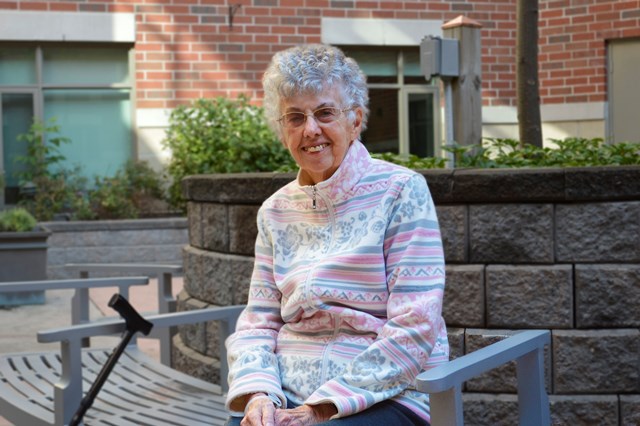By Michael Oreskovich
Struck by a severe case of double pneumonia, 90-year-old Doris Dunne felt for the first time that her health was at risk. Physically weakened following treatment of her acute symptoms and susceptible to potentially life-threatening falls, Doris was unable to be discharged back to the community. Instead, she was admitted to Runnymede Healthcare Centre’s Low Tolerance Long Duration Rehabilitation (LTLD Rehab) program to help her get the care she needed to safely transition back to the independent life she enjoyed at home.
According to a 2010 report by the Public Health Agency of Canada, between 20% and 30% of seniors fall each year, a figure that is influenced by risk factors such as persistent weakness. Runnymede’s LTLD Rehab program helps patients like Doris restore strength, mobility and the skills needed for day-to-day living through low-intensity rehabilitation. Since 2012, the program has provided a safe bridge to home from acute care for over 1,500 patients recovering from injury or surgery.
Upon her admission to LTLD Rehab, Doris was able to feed and dress herself, but had limited mobility and was challenged by her new physical limitations. Runnymede’s interprofessional team assessed Doris and developed a personalized treatment plan to increase her strength and ease her back into daily activities. “We focused on restoring her strength, mobility and independence,” said Runnymede patient care manager, LaVerne Edwards. “Doris was committed to getting back home to resume her active life, so we set high goals with her to help her reach this target.”
Once the physiotherapy team had addressed Doris’s strength and balance, they gradually introduced her to uneven walking surfaces that simulated what she would encounter upon returning to the community. Support from Runnymede’s occupational therapy team complemented these gains. “We helped Doris adapt to using a cane, and coached her to avoid falls and conserve her energy,” said Nicole Digout, occupational therapist. The team then focused on restoring Doris’s capability to safely perform day-to-day tasks – like preparing meals and bathing – in a simulated kitchen and bathroom.
The occupational therapists continued helping Doris to safely practice her routine activities by accompanying her on shopping trips. “We made each trip more challenging for Doris as she got stronger,” said Digout. “After she mastered taking the bus, we introduced a shopping bag for her to hold; once she got comfortable with that, we added extra weight to mimic a real-life shopping trip.”
Less than a month after her admission, Doris was back on her feet, ready to go home and resume the active life she was used to. Had she been discharged directly back to the community from acute care, her recovery likely would have been slower and she would have been at higher risk of falling. The level of rehabilitation Runnymede provided safely bridged the gap between acute care and her home. “I think it’s amazing to have been as sick as I was, and to be back at the level I’m at today,” Dunne said. “I’m sincerely grateful to the people at Runnymede for my recovery – it’s a blessing to have this hospital in the community.”




